- HOME>
- Digital Camera Basic Knowledge>
- Maintenance
![]()


- Digital cameras can have problems dealing with moisture, dust, high temperatures, and high humidity. Take care that your camera does not get wet when it is raining, and definitely do not try to operate the camera when your hands are wet because it could result in a malfunction or electric shock. Dust can get on and into your camera on windy days as can sea salt when you go to the beach: both can do bad things. In environments where there are drastic temperature changes, care should be taken because condensation can cause water droplets to form inside the camera.


- By using one of the commercially available waterproof camera cases, you can shoot on rainy days and operate your camera with wet hands. Such cases will also keep dust off and out on windy days and do the same for sea salt at the beach. They also help prevent condensation by easing the temperature changes affecting the camera itself. When in transit on a rainy or windy day, it is a good idea to put your camera in a bag or camera case rather than carrying it exposed.


- Subjecting your camera to impact shocks (by dropping it, hitting something with it, etc.) is, of course, strictly prohibited. Take particular care not to let anything strike the lens or picture display. Cameras can also have a hard time coping with the vibration that occurs when traveling by bicycle, motorcycle, or car. Such vibration can cause malfunctions so please take adequate care.


- A strap is effective in preventing camera dropping. When carrying and shooting with your camera, it is a good idea to either hang it around your neck with a neck strap or around your wrist with a wrist strap. Also, when placing your camera on an elevated surface like a table, take care that the strap is not hanging over the side because something could catch on it and pull the camera off and onto the floor.


- When you are moving around, it is a good idea to carry your camera in a case whenever possible. Even if the camera is being carried in a bag, keeping it in a case will reduce the shocks, and prevent the scratches, caused by bumping against other objects. Care should also be taken when putting the bare camera in a clothes pocket as it is easy for dirt and dust to adhere.


- If the surface of the picture display gets scratched, the display becomes more difficult to see. It is a good idea to prevent this by applying a commercially available protective film. Some protective films also have an antireflection coating to reduce picture display glare.
![]()
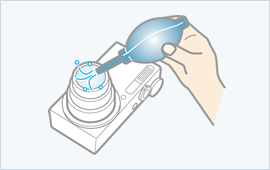

- Turn off the Auto Power Off function before performing this procedure. Use a commercially available blower to blow dirt and dust off the camera body. A brush can be used to remove dirt and dust not removed by the blower. To avoid touching the lens directly, the blower should also be used for dirt and dust on the lens.
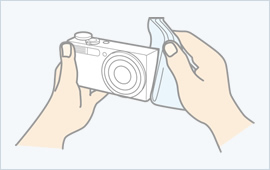

- Wipe the surface of the camera using a soft cloth, such as a commercially available camera cleaning cloth. Take care because rubbing too hard can cause small scratches. Turn off the camera before performing this procedure.
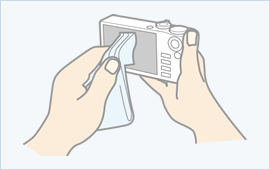

- Place a small amount of commercially available LCD screen cleaner on a soft cloth and lightly wipe the picture display. It can also be convenient to use the moistened wipes that are available for cleaning LCD screens. Take care because rubbing too hard can cause small scratches and give the surface a cloudy look. Turn off the camera before performing this procedure.
*Use the setup menu to set Auto Power-Off.
The operating procedures for the setup menu may vary depending on the model of camera used. Refer to the instruction manual that came with the camera for further information.
![]()
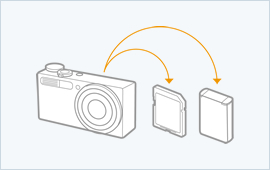

- If you will not use the camera for a long period, please store it with the battery and memory card removed. With battery in the camera, even when the power is off, a small amount of electricity flows. This could result in over-discharge and render the battery unusable.
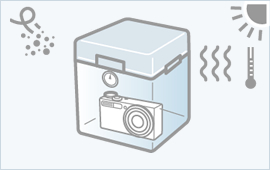

- When storing your camera, it is a good idea to use a relatively cool location that is as dry as possible. Avoid very hot and very cold locations as well as places where there is moisture. In order to prevent mold as well as avoid dirt and dust, for long-term storage we suggest that you use a commercially available dry box or something similar.
